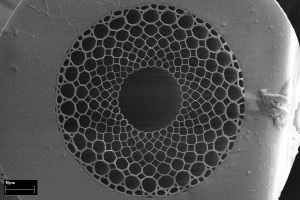Oct 28 2008
Researchers of the Max Born Institute for Nonlinear Optics and Short-Pulse Spectroscopy (MBI) have developed a novel optical fiber that enables transmission of ultrashort light pulses with an unprecedented low degree of distortions.

The researchers transmitted light pulses of 13 fs duration (1 fs = 1 millionth billionth of a second) over one meter distance, with the pulses only stretching to about double of the initial duration. “Currently, no other fiber-based technique is capable of such little distortion”, says Dr. Günter Steinmeyer. In comparison, using similar fibers of a more conventional make, pulse stretching to more than 50 times the original duration was observed. The novel fibers may be useful in medical applications, e.g., for guiding femtosecond pulses to the patient in a flexible manner. In their advance online section, Nature Photonics reports about this novel type of fiber.
The MBI fiber consists of many glass capillaries and guides the light on a diameter equal to about half the diameter of a human hair. In contrast to conventional hollow fibers, which consist of capillaries of equal diameter, the diameter changes in MBI’s novel fiber (see figure). This can be understood as gluing straws side by side, yielding a tube of straws when the first and the final straw are also glued together. Repeating this procedure with straws of different diameter and fitting the resulting tubes into one another ultimately yields a structure similar to MBI’s fiber. For manufacturing the fiber, the researchers have used 5 such tubes of straws. Referring to the systematic change in capillary diameter, the researchers call such a structure chirped. Launching ultrashort laser pulses into such a fiber, the chirped structure acts to distribute detrimental resonances over a wide wavelength range, which would otherwise add up at one wavelength if the capillaries had all the same diameter. The fiber was manufactured at Saratov State University in Russia.
The researchers see one particularly interesting medical application of their fiber in photodynamic therapy. For this method, a photosensitizer is accumulated in cancerous cells. Exposing the photosensitizer to light, a substance is formed which causes fatal damage of the tumor cells. Using ultrashort laser pulses rather than continuous light, the selectivity of this therapeutic method could be significantly improved as the photoexcitation could be limited to the immediate vicinity of the focal area, whereas tissue layers immediately above or below the interaction zone would stay unharmed. So far, however, no fiber was available to guide the required short light pulses to the patient in a flexible way without severe distortions through an endoscope. The chirped fiber structure could also be beneficial for diagnostic applications in biology and medicine, such as in two-photon microscopy, a method that allows for three-dimensional resolution of smallest biological structures at effective suppress.